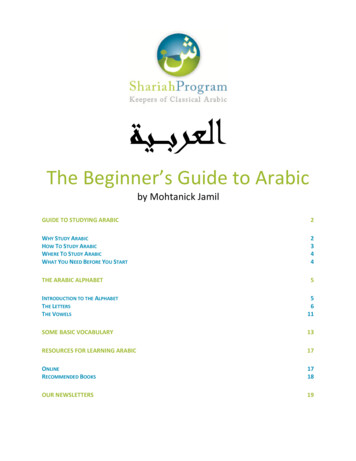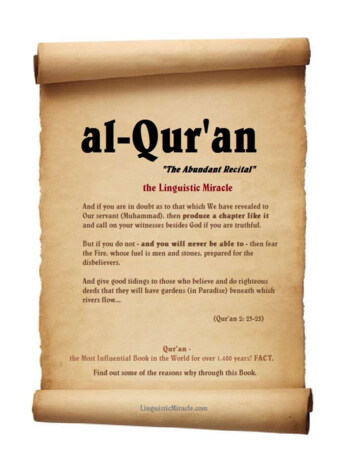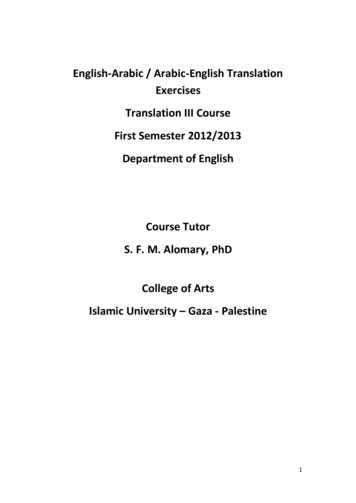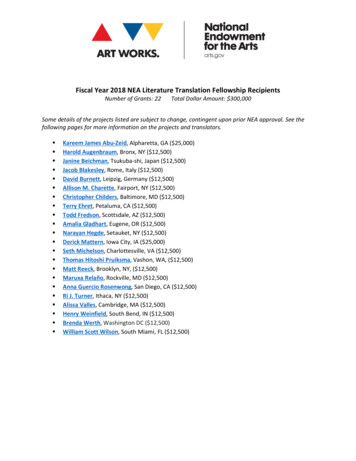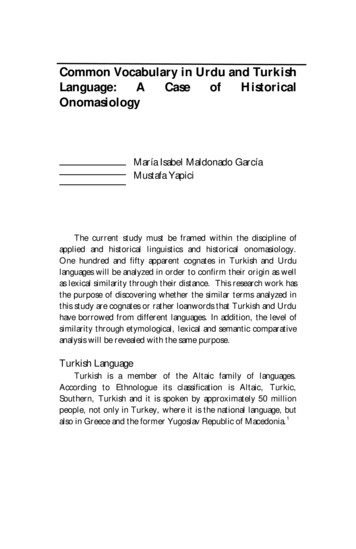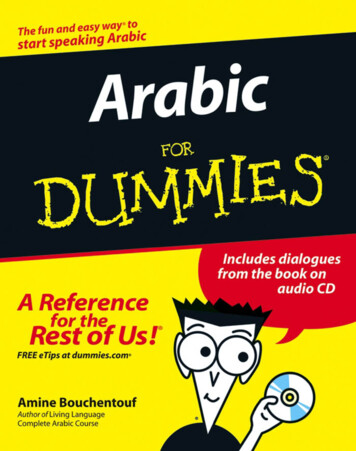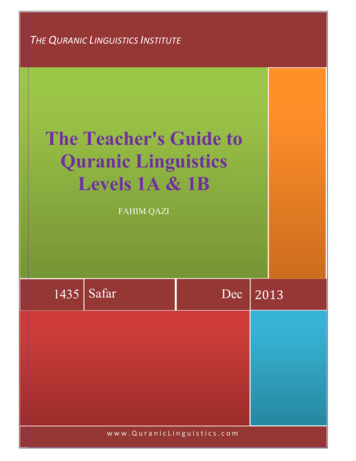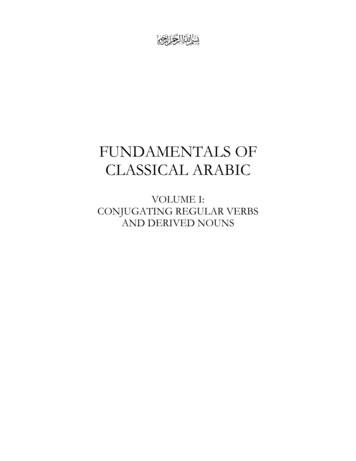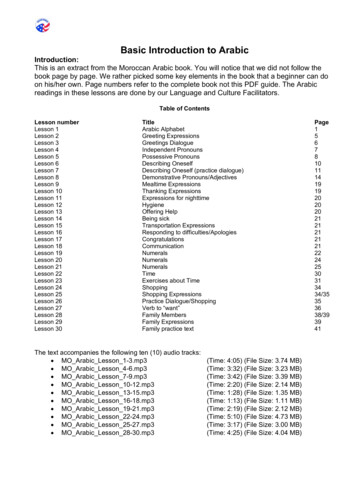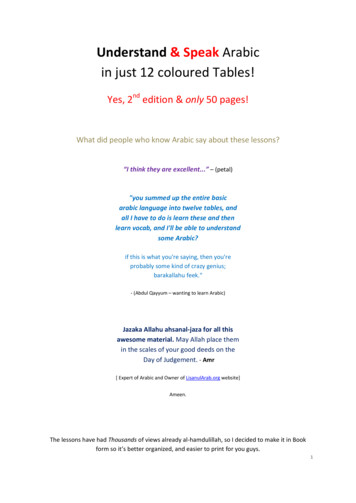
Transcription
Understand & Speak Arabicin just 12 coloured Tables!Yes, 2nd edition & only 50 pages!What did people who know Arabic say about these lessons?“I think they are excellent.” – (petal)"you summed up the entire basicarabic language into twelve tables, andall I have to do is learn these and thenlearn vocab, and I'll be able to understandsome Arabic?if this is what you're saying, then you'reprobably some kind of crazy genius;barakallahu feek."- (Abdul Qayyum – wanting to learn Arabic)Jazaka Allahu ahsanal-jaza for all thisawesome material. May Allah place themin the scales of your good deeds on theDay of Judgement. - Amr[ Expert of Arabic and Owner of LisanulArab.org website]Ameen.The lessons have had Thousands of views already al-hamdulillah, so I decided to make it in Bookform so it’s better organized, and easier to print for you guys.1
Contact: LinguisticMiracle@gmail.com for support.Contents:Introduction - . - P3Lesson 1: 3 Letter Patterns . - P4Lesson 2: 2 Letter Verbs (Doing Words) - P5Lesson 3: 2 Letter Words (Connectives) - P6Lesson 4: 1 letter Words . - P8Practise Test . . P10Lesson 5: 3 Letter Words - Past Tense . - P12Lesson 6: 3 Letter Words - Present-Future Tense - P143 Letter Words Summary - . - P16Lesson 7: Possession - his, her, their, our etc. . - P17Lesson 8: 1 Object (Singular) 2 Objects (Dual) 3 Objects (Sound Plural) . - P18Lesson 9: Broken Plurals - . - P20Lesson 10: Verb Patterns Table *Muscling up Words* . . - P21Lesson 11: I'raab - the "Moods" of a Word: - . - P24Lesson 12: Harf al Jarr & MaJzoom - . - P26Online Resources: Dictionaries Books Websites Arabic-Typing softwares - P27Balaaghah & Eloquence Gems:Past tense vs Present-Future tense . . - P28Noun (constant) vs Verb (temporary) . . – P29Female Plural for non-female Objects Handful (less than 10) . – P29Exclusivity (taQdeem / IkhtiSaaS) . - P30What you've learnt from this Book: . - P31What Next.? . - P31Let's Practise what we've Learnt: . - P32How to Speak Arabic Sentences (NEW!) . . - P362
Other books & sites by the same Author . .p46Introduction: Is this Book for You?These lessons are created for people who already know how to read Arabic with vowel markings but can’t understand it, and will allow you to understand Arabic within 2 weeks (if you're a reallygood memorizer), or a month (if you're a slower memorizer) inshaa' Allah. However you willcontinuously have to refer to these tables for revision for maximum benefit.How does it work?I have made some coloured Learning Tables, you have to memorize them. And we move onto thenext lesson. Simple (smile.)Also note, you may find the order of the lessons abit strange (i.e. see the Contents page – I havemade the 3 letter Patterns lesson earlier than 1 letter words lesson), but that is done to make iteasier for you to digest the language.Arabic Layout:Arabic is made up of; 1 Letter words, 2 Letter words, 3 letter words, and sometimes 4 letter words.I will work gradually in presenting 1 Table per lesson, you have to memorize the table as much asyou can. I will then briefly give an explanation of that Table. Then we move onto the next lesson. Iwill then give a practise Test after a few lessons.After 2 weeks:Once you have memorized the tables altogether, you will have got a strong feel of how Arabiclanguage works. This will make it extremely easy for you to understand the language when readingand hearing; Qur'an, Sunnah, or an Arabic speech etc.NOTE: you can download all the tables from HERE at once in ZIP format.Last Advice:You have to make du'a (prayer) to Allah if you really want to learn Arabic, and Allah will help you. Itworked for me, alhamdulillah!3
Lesson 1: 3 Letter peed2kx/ktb-arabic-3-letter-words.pngWhat you should know:1 - Most words in Arabic are made up of 3 Lettered words.2 - 3 Letter words usually describe the Doer (noun) or the 'Doing' (verb).3 - These 3 Letter words have different vowel markings (tashkeel) on them.*4 – The vowel markings tell us if the 3 letter word is a 'Doer' or a 'Doing'.5 - I have used the Root word example: 'K-T-B' to Write. [it is a verb/doing word].To make the root word K-T-B (‘Write’) into a 'Doer' would be to add the marking signs; 'KaaTiB' WritER.Your Task: Memorize this table, along with the different vowel patterns. And use the examples topractise it to other 3 Letter words.Practise Example #1: (i.e. QaTL [Q-T-L] to Fight. QaaTiL FightER. QiTaaL FightING. etc.]st*BIG cheat TIP: Usually on the 1 letter of a word, if the vowel is:A (fat-ha or zabar) Active voice [usually a Doer is mentioned.] (example kAatib an Active Writer.)U Passive voice (damma/peysh) Passive voice [usually a Doing is mentioned & not the Doer]. (kUtb Books)4i Tool. (kasra/zeyr) a Physical Tool or Physical Concept. (kItaab Book. qItaal Fighting).
Lesson 2: 2 Letter Verbs (Doing ed2kx/2letter verbs-2.png5
What you should Know?1 - a 2 Letter Verb has different rules to a 3 Letter Word, although they both have somesimilarities aswell. You have to memorize the patterns for both the; 2 Letter Verbs and 3Letter Word tables.2 - After memorizing the patterns, then Practice with the Examples given at the bottom:Example #1: Q-M (stand) - QaaMa (following the pattern of QaaLa - he Said) He Stood (pasttense.)Example #2: Q-M (stand) - QuM! Stand! [command]. Just like; QuL! Say! [command].Example #3: Q-M (stand) – yaQuwm he is Standing. Just like: yaQuwL he is Saying.3 - The same patterns apply for any other 2 Letter Verb (doing word.)6
Lesson 3: 2 Letter Words (Connectives) This page will has a list of words which are used to Connect words in a sentence together.Most of them are of 2 letters, but there may also be some of 3 letters.Your Aim: Memorize these words or refer back to them as a Dictionary/Glossary.WordMeaningAl ( ) اَل TheAl-ladhee ( )الَّذِي “The one Who” [specific to someone]“Who” [general]similar to: Man ( ) َمن Ayy ( )اَي WhichAw ( )اَو OrOrIdh ( )اِذ When (past tense)Idhaa ( ) ِا َذا When (future tense)Idh-an ( ) ِا َذن ‘In that case’In ( )اِن IfInna ( ِن ََّّ )ا SurelyAn ( ( )اَن with Letter Alif-Hamza at front)That'An ( عن َ ) (with Letter 'Ayn)'In regards to' (sometimes translated as; 'From')Ilaa ( )ىلِا Ilaa To‘Alaa OnAm ( )اَم similar to: 'Alaa ( ىَا ) ل Il-laa (َّ ل َّ ) ِا ExceptAl Aan ( )اآلن NowAyDan ( ضن َ )اَي AlsoBi ( ب َِّ )With (Help: i.e. with his power.)With (Association: i.e. with a friend)similar to: Ma'a ( ع ََّ ) َم Jaa' ( جاء َ )similar to: Ataa ( )أت ى Came (a Great thing.) a Past tense word.Came (a Lighter thing.)7
Ja'al ( ج َعل َ )to Make.Jiddan ( ج َّدا ِ )VeryHal ( ) َهل at beginning of sentence to signify – Question.UntilHaadhaa ( ) َه َذا ThisDhaalik ( ) َذلِك ThatFa ( ف ََّ )Then / SoFee ( )فِي InQad ( ) َقد Had / Have / HasKun ( ) ُكن BeKaana ( ان ََّ ) َك WasLi / La ( ل ََّMeaning either: “For” or “Surely.”Hat-taa ( )ح َّتي / ل َِّ )Laa (َ ل َّ )NoYesMin ( )مِن FromMan ( ) َمن WhoHuwwa ( ُو ََّ )ه HeHiyya ( ِي ََّ )ه SheHum ( )هُم Them (males plural)Hun ( )هُن Them (female plural)Haadha ( ) َه َذا ThisHuna ( ُن ََّ )ه HunakHuna Here Hunak ThereWa ( و ََّ )Andrelated: Na'am ( ) َن َعم 2letter connectives.png8
Lesson 4: 1 Letter WordsWhat you should Know:1 – Don’t get overwhelmed with the amount of information on the 1 letter words sheet (next ed2kx/LEARN%20ARABIC%20TABLES/1 letter words arabic.png2 - Remember I told you that there are 3 Root Letter words (in Lesson 1), and 2 Root Letter Verbs (inLesson 2)? Then yes they are. But if you've ever read Arabic, you're probably aware that all thewords in a sentence are written together flowing, so you can't actually separate the different words.Most importantly, you can't figure which are the 3 Root Lettered and 2 Root lettered words in thesentence, in comparison to other letters in the sentence.3 - This 1 Letter Word table (I call it a Cheat sheet), will let you find out What the 1 letter wordswhich surround the 3 and 2 Root Letter words mean.Example #1: If we look at letter ALIF, we see that it has quite a few meanings when placed at the BEGINNINGof a 3 Letter word. You have to memorize those meanings, all of them. So memorize the rules of as manyletters as you can (whenever you have time.) Even if they don't make some sense to you yet!Note: I know you will have some confusion at this stage, like why the letter 'Taa' has the meaning of 'you' and'she' at the same time. But because you're a new learner of a new language, you just have to memorize therules, and once you've finished this book, you will see it will make sense altogether inshaa' Allah.4 - If you can memorize this table, you will have SO much knowledge of Arabic, that the rest of thesheets will be extremely easy for you (this table summarizes a few books worth of Arabic lessons.) Soput alot of effort into memorizing this Table, even if it takes up most of the days of these Arabicstudies.5 – Make SURE you look at EVERY detail, especially the Colour of the text of the Arabic &English, because that will help you understand everything a lot more accurately.For example you might wonder how you can differentiate between;- “I” (1st person) [i.e. AslamTu],- Maximum meaning (i.e. A-Kbar [BiggER]) and- “he” (3rd person) because they all have ALIF at the front. You will notice that the last vowelmarking in red - AslamA has shown that it is 3rd person. So every small detail on all tables isextremely important to notice.Also NOTE: When 1 letter has 2 words for one meaning (i.e. Sa and Sawfa Soon) – then youmemorize both words. (Sa is a shortened form, just like people say “Thx” for “Thanks” in English.)6 – I have tried to fit it all on one page so it is easier to study from 1 printed page.9
10
Here's a Practise Test now:Note: You are allowed to look at the colored tables from the lessons given based on what you havelearnt.Question #1: - Tell the Meaning;Khalaqa-kum min Nafsin waahidah, thumma ja'ala min-haa zawja-haa - [Surah al-Zumar 39:6]Vocabulary you need to know:Khalaq to Create. Nafs Being (Soul body.) Waahidah One. thumma then Ja'al to Make. Zawj partner.Question #2a If Husn [ س And AHsan [] Good. س ] the Best Good male. (Alif attached at the beginning to 'maximize meaning')Then what word is used to describe the 'Best Good female'?#2b - Sughr [ ] ص غر small. Make the 'maximum' [known as; ism al tafDeel] meaning of it in Maleand Female maximized form.NOTE: Look at 1 letter sheet, letter ALIF. If you are unsure.11
Question #3 - What does this mean? ر ر ر [Quran surah al Anfal 8:48]Vocabulary help:Inna surely baree' (from baraa') disassociate / separate. Raa see Khaaf [khawf] fear. Shadeed Severe/firm. 'Iqaab [from - 'Uqb] Ending/Outcome.4 - Translate: ر Dhaalim [Dhulm wrongdoing/oppression/darkness].5 - Translate: س [Yusuf 12:22]Lam-maa "Until when" balaagh [] - to reach from one point to another(i.e. a child who reaches another stage in life [maturity] baaligh []].) [or even a speech is'balaagh' because the speaker says it, and it reaches to the listeners ears.])AShudda [shudda firm]. The Alif before it represents Maximum meaning.Ataa to Give.Hukm wisdom/judgement'ilm knowledge.Jazaa reward / payback12
Lesson 5: 3 Letter Words – Past TenseMemorize this ed2kx/3letter past verbs.pngWhat you should know:1 - You will notice in Arabic that in PAST TENSE verbs (doing words), the 'DOER' is mentioned at theEND OF WORD.i.e. Darab-TU I hit. Darab-TA YOU hit dArAbA He hit. Darab-TUMAA YOU (TWO) Hit Darab-TUM YOU (plural [3 people]) Hit. 2 - You will see (in next lesson) that in PRESENT TENSE verbs (doing words), the 'DOER' is mentionedat the FRONT OF THE WORD.3 – If we practise this table on other 2 or 3 Letter words, it also works most of the time (the times itdoesn’t, simply check back on the 2 Letter Verb sheet.)3 Letter: QaTaL-tu (I Fought) QaTaL-TA You fought QaTaL-TUMAA qAtAlA QatalOO They Fought etc.2 Letter: QuL-tu (I said) QuL-TA You said Qul-TUMAA(you both said) Qaala (he said) Qaaloo (they said).13
Lesson 6: 3 Letter Present-Future TenseMemorize the table (it’s on the next ed2kx/3letter present verbs.pngWhat you should Know:0 – In Arabic, there are only 2 Tenses:- ‘Past’ tense (called; MaaDiy), something which has no doubt already happened. The other is- ‘Present-Future’ tense (muDaari’), something which ‘has not passed yet’ (i.e. the present andfuture.)I.e. “I (am) Hitting” (aDribu or aDrib-tu) is Present-Future tense because I am Hitting now (presenttense) and this hitting is continuing for 2 more seconds (Future). Once it has happened, it willbecome Past tense (Darab-Tu I Hit).1 - In PRESENT TENSE verbs (doing words), the 'DOER' is mentioned at the FRONT OF THE WORD.(unlike PAST TENSE words where the 'Doer' is mentioned at the End.)2 - When the Prefix letter 'Ya' (meaning 'he' or 'they') has a;- Fat-ha (zabar) on top - it means Active Voice. I.e. 'He' (or 'they') are Doing the Action. (i.e. areyaDrib he (is) Hitting.)- 'Damma' (peysh) on top of it - it means Passive Voice I.e. 'He' (or 'they') are being Done'. (i.e.yuDrab he (is) being Hit.)3 – Letter ‘Taa’ ( )ت must be the most confusing for most people, so I will explain this one: - The Letter “Taa” ( )ت when placed before a word means either; ‘You’ or ‘She’. It will normallyalways mean ‘You’ unless there is proof in the sentence for it being a female.(i.e. al Mar’atu Ta-Drib the Woman is hitting). If it is many women, it is “al-Nisaa ya-Drib-NA”(many women are Hitting.)When it means ‘You’, females will not be in the sentence. I.e. ta-Drib You are Hitting. ta-Driboon You males (plural) are Hitting. ta-Drib-Na – they (females) are hitting.The rest of the examples are easy to understand I hope.14
15
3 Letter Words peed2kx/3letter summary-1.pngWhat you should Know:1 – This sheet is a summary of the previous lessons, so it’s a good sheet to revise from.2 – The vowel markings (tashkeel) in orange can change depending on the word. Most of the timesyou will know what vowels are used when you check Dictionaries, or when you hear someone sayingit a certain way.16
Lesson 7: Possession - his, her, their, our 2kx/possession.pngKEY: S or Sing. Singular D Dual [2 people] P Plural (3 people) M Male F Female.What you should know:1 - Objects [Nouns] are 'possessed' (owned) by someone.2 - Objects are also made up of 2 or 3 Letters.3 - When an Object is mentioned, its Owner is mentioned at the End. (i.e. Sayyaaratu-Hu His Car.)17
Lesson 8:1 Object (Single) 2 Objects (Dual) 3 Objects (Sound Plural)What you should Know:1 - Work on the table from Right to left (the table is on the next page).2 - Objects are classed into either; 'male' or 'female'. (There is no word for 'it' [genderless] in arabic.)So one Male ”Praiser” is; Haamid-un. One Female Praiser is; HaamidaT-un3 - An Object [Noun] will have Letters attached to its end, to show the number/amount of Objects.i.e. Male: Haamid-un one Praiser. Two Praisers Haamid-ayn. Three or more Praisers areHaamid-oon.i.e. Female: HaamidaT-un one Female Praiser, Haamida-T-ayn, Haamida-T-OON. etc.4 - In Arabic, when you talk about an Object. You either say; A Object, or The Object.The Object is a Specific Object you are talking about. (I.e. I saw the Praiser [one who praises]) ALHaamidU.A Object is not specific (I.e. I saw a Praiser [one who praise]). Haamid-UN.18
objects.png19
Lesson 9: Broken Plurals20
Download Broken Plurals ed2kx/LEARN%20ARABIC%20TABLES/broken plurals.pngWhat you need to Know about the Broken Plurals Table:1 – Memorize the Table.2 – The Broken Plural patterns can be best memorized by memorizing the examples with them.3 – You find the Plural form of a word by checking Dictionaries.4 – It doesn’t matter if a broken plural has taNween (a letter ‘Nun’ attached at the end). I havesimply divided them into ‘taNween’ and non-taNween ones so it is easy to sub-divide them. Your jobis just to memorize all of them.21
Lesson 10: Verb Patterns Table *Muscling up Words*This is when Arabic gets really speed2kx/Sarf VERB PATTERNS.jpg (Table on page after next page)What you should know:1 - If you have looked at the Past Tense and Present Tense Lessons, then you know that:dArAbA he Hit [past tense], and Ya-Drib He is Hitting [Present tense].This table uses: Fa3ala [he did], yaF3alu [he is Doing], Fi3Lun [to Do] as the main example. [3 letterAyn]2 - There are many verb patterns in Arabic. A sister (we ask Allah to accept her good) has made atable which summarizes an entire book into this small, useful coloured table.So now we have a table with 10 of the main Arabic Verb Patterns used in the Arabic language.3 - Study the table from the Left to the Right. -- Now let's study the Table:Verb Pattern 1 - to Do is the normal Pattern of:Fa3ala [he Did] - yaF3alu [he is Doing] - Fi'lun [to Do.]The meaning is basic, simply 'to Do' the verb [doing word] that is being said. i.e. Daraba he Hit.Now if we look at Verb Pattern 2 - Intense/Repetition, we see the word:Fa33ala (we see the 2nd root letter has been repeated twice [shadda/emphasised].)Try saying out loud; DaRRaba! (he Hit intensively/repeatedly [past tense]) - yuDaRRibu! (he is Hittingintensively/repeatedly [present tense]) - taDReeb! - TO Hit intensively/repeatedly [tenseless].You see that you have to say it in a Powerful, Intensive and Repetitive way. And this is exactly whatthis 2nd verb pattern means.22
The 3rd Pattern means; to TRY to do something with someone/thing else.(you see this is hinted atby the long stretch of sound):Faa3ala (he tried to Do with someone else [past tense]) / yuFaa3ilu (he is trying to Do with someoneelse [present tense]) - muFaa3alatun or Fi3aal (to try to Do with someone else [tenseless]).Lets practise an example:Juhd to Struggle. Jaahada (he tried to Struggle with someone else [past tense]) / yuJaahadu(trying to Struggle with someone/something else [present tense]) / muJaahadatun / Jihaadun (to tryto Struggle with someone/something else )The 4th pattern (he does) is one which you should try not to confuse with letter ALIF's othermeanings, which has many meanings (I [1st person], maximize meaning of a word, Question mark,and now this.)How do you remove the confusion? Simply stick to this patterns full rules:Af3alA - you see that it starts with an ALIF (with a fat-ha on it), and it ends with a Fat-ha (zabar) onthe last letter. This is the biggest sign that it is this Verb Pattern 4 and not any of ALIF's othermeanings.This verb pattern means: Doing something to something/someone else, or Causing something else.I.e. AslamA he Submitted / yuSlimu Submitting [present tense] / Islaamun [to Submit]The 5th Pattern (he does himself, repeatedly/intensively [like pattern 2]) taFa33al he did (something) himself repeatedly/intensively – past tense ya-taFa33al heis Doing (something) himself repeatedly/intensively tafa33ulun to Do (something) one’sself repeatedly/intensively.Practise Example: taMaRRuD [from MaRaDa (he was Sick/ill)] (to be sick/ill yourself topretend to be sick/ill.)The rest of the Verb Patterns are also easily understandable - now that you know how the tableworks, inshaa’ Allah.23
24
25
26
Online Resources:Easy to use, Type & Search - Arabic-English Dictionaries:- http://www.ejtaal.net/m/aa (Hans Wehr and Lanes Lexicon – Fast, Searchable, and works on SmartPhones too.)- Lanes Lexicon with English ion?collection glish%20Lexicon- Lanes Lexicon Online - http://www.tyndalearchive.com/tabs/lane/- http://aratools.com/- http://dictionary.sakhr.com/ al Sakhr Dictionary (similar to al the famous al Mawrid Dictionary.)- http://translate.google.com/Downloadable Dictionaries: (open with free Adobe Reader)Arabic-English Dictionary Of Qur’anic Usage (by ELSAID M. BADAWI, & MUHAMMAD ABDEL onary of the Holy Qur’an – by Malik Ghulam Farid [1] [2]:(the author is from the false Ahmadi sect, but the book is reliable inshaa’ Be/dictionary quran.pdfNear Synonyms – a Mini Thesaurus created by Ustadh Nouman Ali quran.co.uk/PRLonline.htm – this site gives you an Alphabet index of ROOT Words, and allows youto find out their meanings from famous e.com QuranGems.com rabic.tvCorpus.Quran.com/qurandictionary.jsp – this site is extremely useful for students of ArabicGrammar, telling the types of words and their forms.Also check here for more Useful Arabic-English dictionaries available g Arabic with Ease:-Download Eiktub.com which is free.-Or you can use ta3reeb google (google.com/ta3reeb) online.-This one you might like alot; http://translate.google.com - you type english and the arabic comes up27
Balaaghah & Eloquence GEMS: Past tense (maaDiy) vs Present-Future tense (muDaari’):Past tense words can be used to describe;1 – Past tense – describing an event which happened in the past.2 – what will NO DOUBT happen in the future, you are so certain that it will happen, that you use apast tense word to argue that it will NO DOUBT happen. (‘as true as the past itself’ - it is as real asthe past was real. (i.e. Judgment Day is sometimes described in the past tense in the Quran toemphasise Certainty of that Day).Example: هض َي ه لَ ه ْ َ اتَتَجْ ِريَ ِمنَتَحْ تِه ٌ َجنه ََُۚ ََّللاَُ َع ْنهُ ْمَ َو َرضُواَ َع ْنه ََ قَا َ ص ْدقُهُ ْمََۚلَهُ ْم ِ اَاْلَ ْنهَا َُرَ َخالِ ِدينَ َفِيهَاَأَبَدًاََۚر ِ َ َ َّللاَُ َٰهَ َذاَيَوْ ُمَيَنفَعَُالصها ِدقِين َْْٰ َذلِكَ َالفَوْ ُزَال َع ِظي َُم Allah will say [on Judgment Day], "This is the Day when the truthful will benefit from theirtruthfulness." For them are gardens [in Paradise] beneath which rivers flow, wherein they will abideforever, Allah being pleased with them, and they with Him. That is the great attainment.(Quran al Maa’idah 5:119)We know the word ‘Qaala’ he Said (Past tense.) However, Allah is using this Past tense word todescribe a future event, this emphasises Certainty; Certainly on Judgment Day Allah will say this.This could not be captured in the translation.Present-Future tense (muDaari’) describes:1 - Present-[near]-Future – something which is happening now. (I.e. I am eating now, and in thepresent[near]-future I will still be eating this food).2 - Present-[long-term]-Future – something which is happening now AND will continue in the Longterm future (istimraar-continuance).(I.e. Some sentences are said in this muDaari’ [present-future tense] form to show that people are doing anaction now, and there will be people doing the same action in the long term future too.)َ يل ُِ ّللا ُِ س ِب َ يُ َجاهِدُونَُ فِي yuJaahidoona fee sabeel-illah They are [now] (and will [in the future]) struggle in the path of Allah. [Maa'idah 5: 54] there are people today (present) who struggle/fight in the path of Allah now, and there willcontinue (future) to be people who struggle in the path of Allah – as long as this Qur’anic ayah/verseremains being recited on Earth. So Allah has given the believers hope just by using the PresentFuture tense! So next time you see an ayah in the MuDaari’ (present-future tense) – it most likelyimplies that this Action will continue to be done, now, and also continue on into the Future.28
Noun (constant) vs Verb (temporary):Someone/thing can be described in verb (doing [fi'l]) or noun (object [ism]) form in the Arabiclanguage.Noun [ism faa'il] form signifies that the doer always/Continuously does that action (i.e. ‘FightER‘[muQaatil])Verb form signifies that the doer [faa'il] sometimes does that action (i.e ‘he was Fighting‘ [Qaatil]).A FightER (muQaatil) is someone who always fights, whereas someone ‘who is Fighting’ (Qaatil)might be fighting only once in his life.This is why; ( َُ )م ْؤمِنون Mu’minoon Believers are described as Nouns [ism faa'il] Continuouslyalways Believing (through times of ease and hardship and trials/tests/calamities etc.)( )ا َلذِينَُ آ َمنوا al-ladheena Aamanoo’ - those who Believe’ [verb/temporary form] are not as strongin their Beliefs and their Emaan/belief is not as constant as the Mu’minoon.Summary:Mu’minoon strong/continuous Believer.al-ladheena aamanoo’ those who believe sometimes, but sometimes not so strongly.So next time, whenever you see something as a Noun/Object (usually with a ‘Mu’ prefix attachedat the beginning.), then this is a Constant Attribute of that character.Whereas when someone/thing is being described in Verb form, i.e. the pattern of Faa’il [doer],then you know that this Characteristic is only a temporary attribute.29
Female Plural used for non-Female objects ‘Handful’ (less than 10)If Female characters are not being discussed – but Feminine plural is still being used to describethem, it implies:Jam’u qillah/small plural less than 10 objects. (‘a handful of objects’)ِ ِحا Allah says about those who believe and (‘amiluw al-SaalihAAT [ ُ ت َُ صال َ )] َعمِلوا ال do A Few goodactions, for them is Jannah (Paradise.) [see Quran 5:9]This shows the extreme Mercy of Allah. He doesn’t expect too much from His slaves. He just wantsus to be grateful to Him. He wants us to – atleast the minimum – complete the 5 pillars of Islam andto stay away from the haraam (forbidden things.) And then He will reward His believing slaves withJannah (beautiful Gardens in Paradise.)We ask Allah to make us the people of His Jannah (Paradise),ameen ya Rabb.Exclusivity (taQdeem/IkhtiSaaS):When Someone/thing (object) is placed earlier in a sentence when it is usually placed later in thephrase – it is not normal [it is abnormal] sentence structure. Which implies that this person/thingExclusively has that description.For example: People may say;( )حمد لك hamdun La-Ka – Praise is For You. [normal sentence structure]But;La-Ka al-Hamd ( ) لكُالحمد Praise is EXCLUSIVELY For You. [abnormal structure because 'For You'(La-Ka) is mentioned earlier in the sentence, even though it could normally be placed later in thesentence.)This is why, when you recite surah al Fatiha, you say;Iyyaa-Ka [You] – Na’budu [We worship]. – the ‘You’ (iyyaa-ka) is mentioned earlier in the sentencestructure - which implies that we worship ‘You’ [Allah] Exclusively/alone.This is called ( ) تقديم و تأخير TaQdeem (placing Earlier) and Ta’kheer (placing at the End) in Arabiceloquence, and is used many times in the Qur’an to emphasise Exclusivity.30
What you've learnt from this Book:You've learnt; 1 letter, 2 letter, and 3 letter words. This is the majority of Arabic language structure.There are further 4, 5 and 6 letter words. But most of these words meanings can be found inDictionaries anyway. If you wonder how these words are made - then usually they are a mixture of afew 3 letter words fused into each other to make 1 long word.What Next.?Now that you have an overview of how the Arabic language works, you will need to dedicate yourtime in;Building up on your Vocabulary: (use http://80percentwords.com and Dictionaries especiallyhttp://ejtaal.net/m/aa/ )Once you do this, you will be able to understand alot of the Qur'an, Ahadeeth (Prophetic sayings)and Arabic Islamic lectures quite well inshaa' Allah.Then you need to get a copy of the Qur'an in Arabic a translation (http://Quran.com is good) andsee if you can understand the Arabic (do a word by word translation in order of the Arabic words) then check the real translation to see if your understanding was correct.Grammar (Nahw): - this will enhance your arabic skills so you know how to speak the languagewell. (http://ArabicTree.com & iArabic.tv & Sheepoo.wordpress.com/pdf-files/ &http://www.kalamullah.com/learning-arabic.html%20 are good).This is the exhausting part of studying the language because it requires alot of effort (lots of 'rulesand their exceptions'). But if you want to speak Arabic, you need to learn it.Nahw is similar to the I’rab section on the
6 What you should Know? 1 - a 2 Letter Verb has different rules to a 3 Letter Word, although they both have some similarities aswell. You have to memorize the patterns for both the; 2 Letter Verbs and 3 Letter Word tables. 2 - After memorizing the patterns, then Practice with the Examples given at the bottom: Example #1: Q
